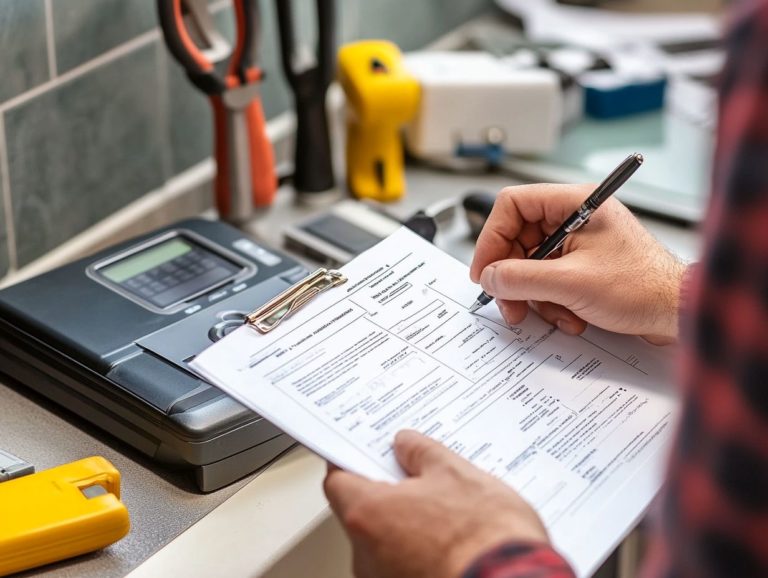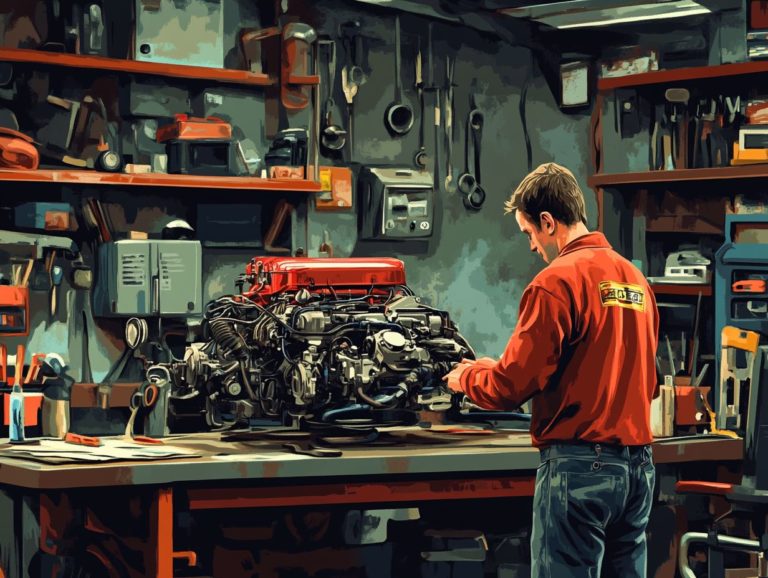DIY Car Maintenance: What You Can Do
Maintaining your car doesn t have to feel like a daunting task reserved for the professionals.
By embracing DIY car maintenance, you can save money, enhance your vehicle’s performance, and acquire valuable skills along the way. This article delves into the benefits of regular upkeep and outlines essential maintenance tasks, ranging from the basics to more advanced techniques.
Get ready to boost your confidence and keep your car running great for miles ahead!
Contents
- Key Takeaways:
- Basic Car Maintenance Tasks
- Intermediate Car Maintenance Tasks
- Advanced Car Maintenance Tasks
- Tools and Resources for DIY Car Maintenance
- Frequently Asked Questions
- What is DIY car maintenance?
- Why should I do DIY car maintenance?
- What are some simple DIY car maintenance tasks?
- Can I do DIY car maintenance even if I have no mechanical experience?
- Are there any risks associated with DIY car maintenance?
- Do I still need to take my car to a mechanic if I do DIY car maintenance?
Key Takeaways:
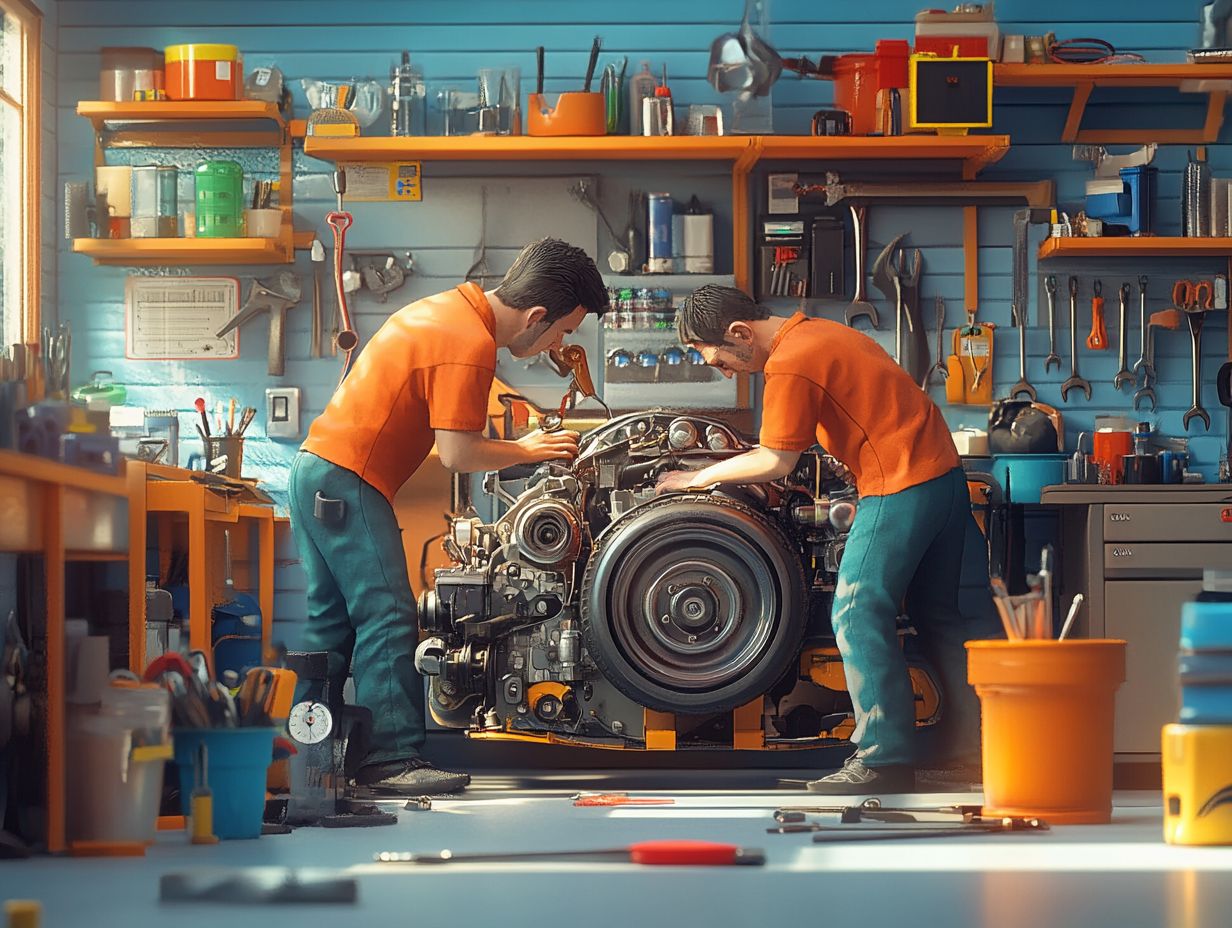
- Regular maintenance is crucial for keeping your car running smoothly and avoiding costly repairs.
- With basic knowledge and the right tools, you can easily perform simple car maintenance tasks like changing oil, replacing filters, and checking fluids.
- For more advanced tasks, such as replacing spark plugs or repairing body damage, online tutorials and guides can provide helpful step-by-step instructions.
Benefits of DIY Car Maintenance
Engaging in DIY car maintenance gives you the power to tackle repairs while deepening your understanding of your vehicle’s inner workings. This ultimately enhances how well your car runs and its longevity.
By gaining knowledge about various auto parts and maintenance tasks, you can save money while ensuring your vehicle remains safe and reliable.
Embracing the DIY culture puts you in control of your maintenance schedule, enabling timely inspections that help you avoid costly breakdowns. Regular upkeep extends the life of your vehicle and significantly reduces the risk of accidents caused by malfunctioning parts.
With the ability to perform straightforward tasks like oil changes, brake inspections, and tire rotations, you become adept at spotting potential issues before they escalate. This fosters a sense of accomplishment and sharpens your ability to make informed decisions regarding larger repairs or upgrades.
This mix of saving money and understanding your car better means you can own your vehicle more confidently!
Importance of Regular Maintenance
Regular maintenance is essential for ensuring your vehicle operates efficiently and safely over time. This includes important tasks like changing oil and fluids, checking tire pressure, and replacing worn-out components to keep your engine performing at its best.
These tasks not only prolong the life of your engine but also enhance fuel efficiency, allowing you to maximize every gallon you use. For example, changing the oil regularly is crucial as it lubricates engine parts, reducing friction and wear, ultimately promoting overall engine health.
Fluid swaps like coolant or brake fluid changes are key in preventing overheating and brake failure two issues that can lead to hefty repair bills. Monitoring your tire health and pressure improves grip and handling, contributing to a safer driving experience while increasing the longevity of your vehicle.
Basic Car Maintenance Tasks
Basic car maintenance tasks are essential for anyone looking to extend the lifespan of their vehicle and ensure safety on the roads. These important tasks typically encompass:
- changing the oil
- checking and topping off fluids
- replacing wiper blades to enhance both visibility and performance
Embracing these routines will not only keep your car running smoothly but also provide you with peace of mind as you navigate the open road.
Start your DIY maintenance journey today!
Changing Oil and Filters
Changing your oil and filters is crucial for car maintenance. Fresh engine oil lubricates moving parts, reduces wear, and enhances overall engine performance. It keeps your vehicle running smoothly and efficiently.
This process helps extend your engine’s life and maintain optimal fuel economy. You’ll enjoy a more responsive ride!
Use the right tools for the job, such as a torque wrench to secure your oil pan bolts and an oil filter wrench for easy removal.
Choosing the correct oil type for your car model is essential. Using the wrong thickness can lead to engine damage over time.
If you skip regular oil changes, you risk oil breakdown. This can cause overheating, decreased fuel efficiency, and costly repairs.
Checking and Replacing Fluids
Checking and replacing fluids, like coolant and brake fluid, is vital for your vehicle s performance and safety. Neglecting these tasks can lead to severe mechanical failures and high repair costs.
Your vehicle needs these fluids to operate efficiently and safely. Coolant regulates engine temperature, power steering fluid eases maneuvering, and brake fluid ensures responsive braking.
Low levels of any of these fluids can lead to poor performance or even serious failures. Regularly monitor their levels to avoid issues!
Be alert for warning lights on your dashboard, strange noises, or difficulty handling the vehicle. These could signal that a fluid swap is needed.
Regular maintenance, such as topping off or replacing fluids, saves you from costly repairs and ensures a smooth, enjoyable driving experience.
Replacing Wiper Blades
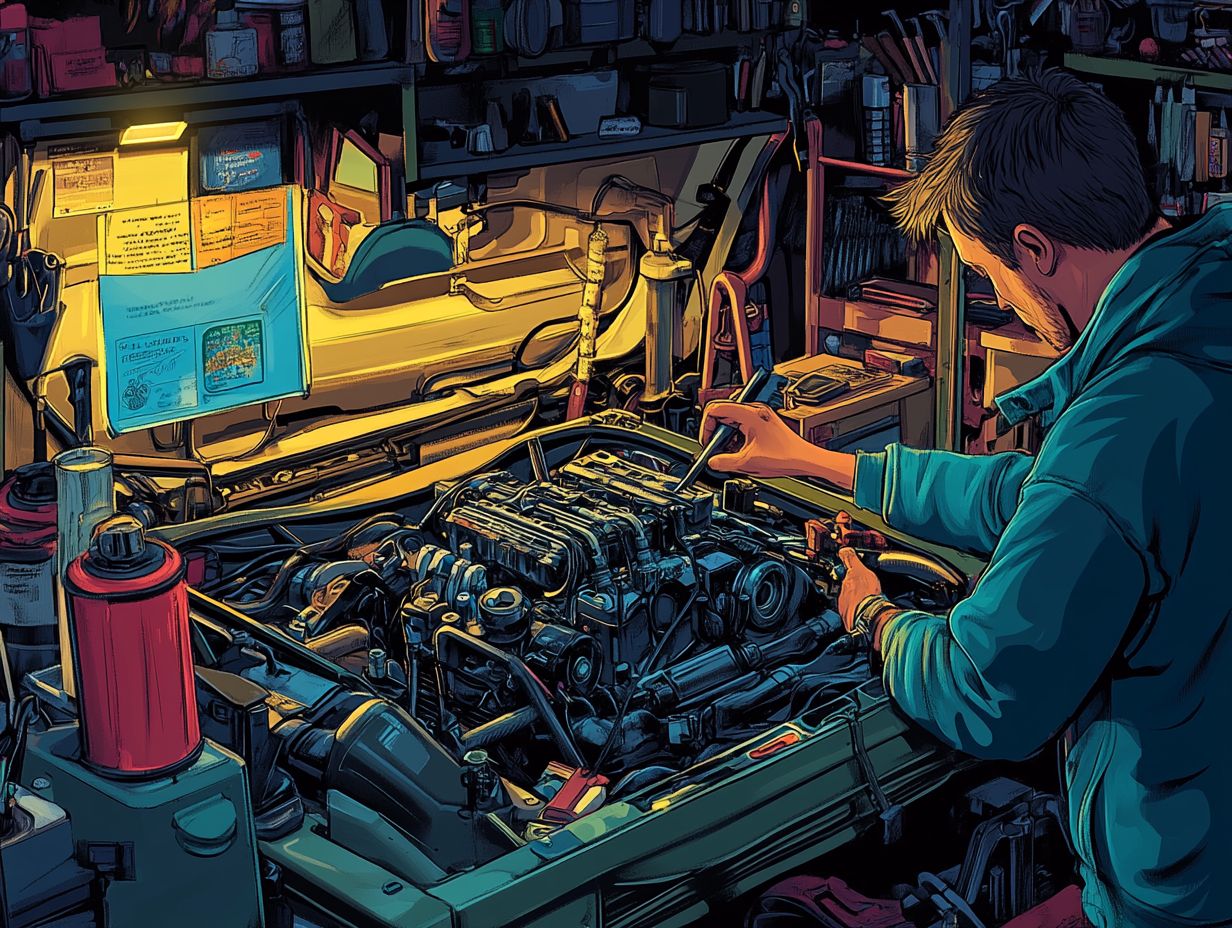
Replacing wiper blades enhances visibility during bad weather. This is essential for safe driving and reduces the risk of accidents!
Start by inspecting your current wiper blades for cracks or uneven wiping. Knowing your car model is vital since wiper blades are not one-size-fits-all.
Most auto parts stores have guides or staff to help you choose the right size and type.
Clear visibility is directly linked to your safety. Regularly check and replace your wiper blades to feel confident behind the wheel.
Intermediate Car Maintenance Tasks
Intermediate tasks require deeper engagement with your vehicle. This includes replacing spark plugs, changing tires, and swapping brake pads.
By tackling these tasks, you enhance engine performance and improve traction and braking safety.
Replacing Spark Plugs
Replacing spark plugs is vital for engine performance. Worn or faulty spark plugs can lead to misfires, lower fuel efficiency, and higher emissions.
Regularly check your spark plugs. If starting the engine is difficult, or you notice rough idling or reduced fuel efficiency, it s time for a change.
When selecting spark plugs, consider your vehicle’s specific requirements and driving conditions.
If you prefer a DIY approach, gather your tools and follow the owner’s manual. A proper fit will enhance engine efficiency and reduce running costs.
Changing Tires
Changing tires is an important skill every car owner should master, as proper tire maintenance including fixing flat tires, rotating, and balancing is vital for your safety, traction, and fuel efficiency.
When you understand how to manage tire-related issues, you re not just enhancing your road safety; you re also extending the lifespan of your tires. Spotting signs of tire wear, like uneven patterns or reduced tread depth, gives you critical insights into when a replacement is necessary. Regular inspections can be your best defense against accidents. Doing so can save you money by catching potential problems early.
By following maintenance practices such as checking air pressure and ensuring proper alignment, you can significantly boost your vehicle’s handling and performance. Mastering these steps gives you the power to create a more secure driving experience while enhancing the overall condition of your vehicle.
Replacing Brake Pads
Replacing brake pads is an important maintenance task that significantly impacts your vehicle’s safety. Worn brake pads can diminish braking performance and extend stopping distances, posing a considerable risk on the road.
As a driver, recognizing the signs that your brake pads need replacement is essential for your safety. Common indicators include:
- Squeaking or grinding noises
- A pulsating brake pedal
- A warning light on the dashboard
By staying alert to these symptoms and addressing them promptly, you can avoid unnecessary repairs and enhance your vehicle’s overall reliability. Choosing high-quality auto parts helps your brakes last longer and work better.
When you take on this task, it s imperative to adhere to safety protocols. Use the proper tools, secure your vehicle on level ground, and don protective gear. Doing so ensures a smoother and safer DIY experience for any car enthusiast.
Advanced Car Maintenance Tasks
Advanced car maintenance tasks demand a higher level of skill, encompassing essential procedures like replacing timing belts and addressing body damage. Engaging in these tasks is vital for preserving your vehicle’s reliability and maintaining its aesthetic appeal over time.
Replacing Timing Belt
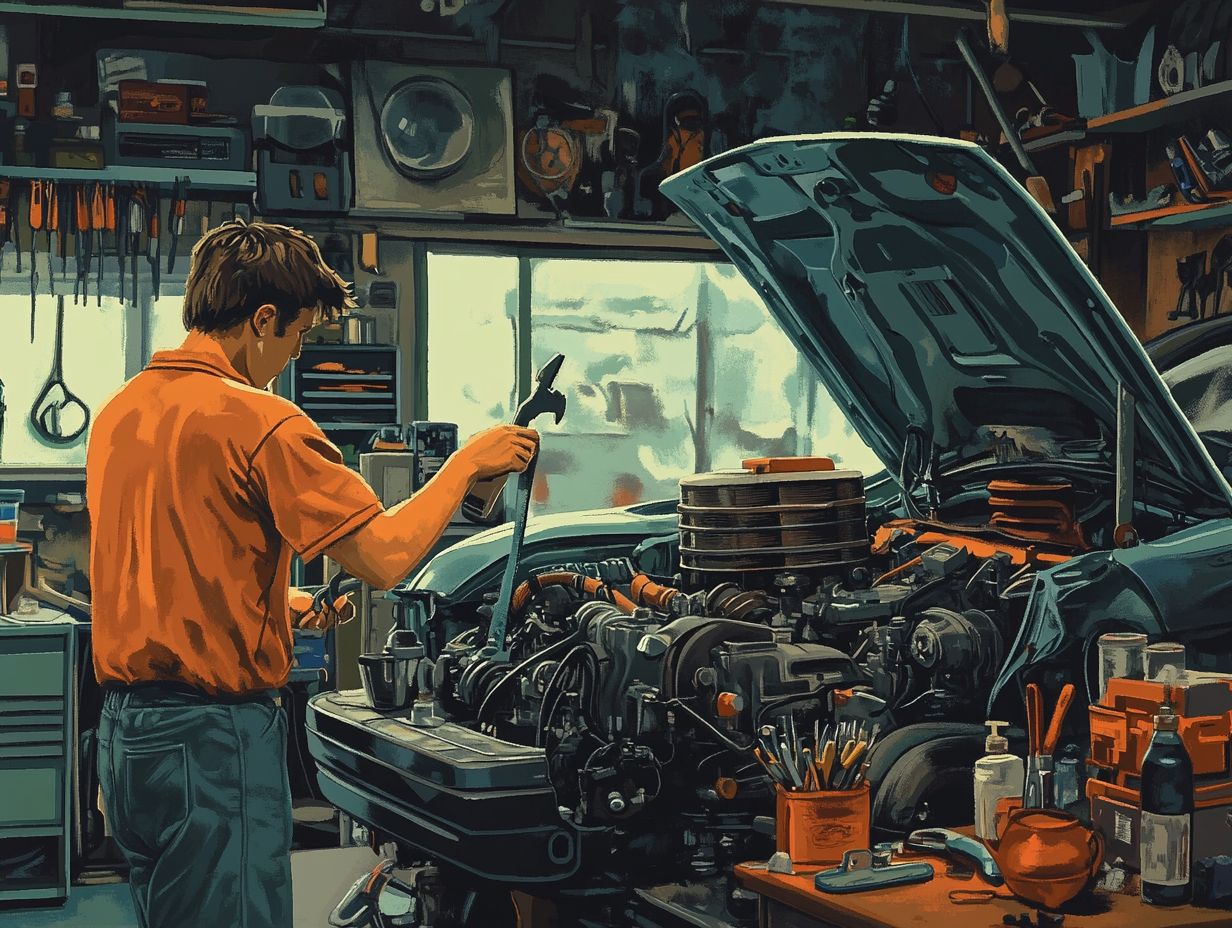
Replacing the timing belt is an essential maintenance task that you cannot afford to overlook. A broken timing belt can lead to catastrophic engine failure, drastically impacting your vehicle’s performance and reliability.
Recognizing the signs that mean a timing belt replacement is needed can save you from unexpected breakdowns and costly repairs. Common indicators include a high-pitched whining noise when your engine is running, visible cracks or wear on the belt, and engine misfires. Ignoring these warning signs can lead to severe damage, compromising engine integrity and negatively affecting fuel efficiency.
If you re considering a DIY approach, it s crucial to follow a step-by-step guide, which includes:
- Preparing your workspace
- Ensuring proper alignment of the new belt
- Securing all components correctly
Meticulous attention to detail is paramount for a successful replacement.
Repairing Body Damage
Repairing body damage, including buffing out those pesky paint scratches, is essential not just for maintaining your vehicle s aesthetic allure, but also for preserving its value and protecting it from rust and corrosion.
Addressing these imperfections enhances your vehicle’s appearance and prevents further deterioration over time. Common methods for repairing body damage vary from straightforward DIY techniques like applying touch-up paint or using a buffer to smooth scratches to more involved processes such as dent pulling or panel replacement.
While you may feel confident tackling minor repairs, it s crucial to know when to enlist professional help for significant damage. A skilled technician can ensure that repairs are executed correctly, utilizing high-quality materials and techniques that uphold the integrity of your vehicle s finish.
Tools and Resources for DIY Car Maintenance
Equipping yourself with the right tools and resources is crucial for successful DIY car maintenance. With essential automotive tools like wrenches, battery testers, and jacks at your disposal, you empower yourself to tackle maintenance tasks with both efficiency and safety. This ensures your vehicle runs smoothly for years to come.
Essential Tools for Car Maintenance
Essential tools for your car maintenance arsenal include a torque wrench, battery tester, and fluid siphon each critical for executing various repairs and ensuring your vehicle performs at its best.
The torque wrench is your go-to for tightening bolts to the manufacturer s specifications. This crucial step enhances safety and performance. When used correctly, it prevents damage from over-tightening or loosening.
A battery tester is invaluable for checking battery problems, giving you peace of mind by confirming your battery s health before you hit the road. Meanwhile, the fluid siphon streamlines the fluid transfer process, whether it s oil or coolant, making it easier to avoid spills and maintain a tidy workspace.
Choosing quality automotive tools is a game-changer! It boosts your efficiency and ensures long-term vehicle reliability, ultimately saving you money over time.
Online Tutorials and Guides
Online tutorials and guides, especially those on platforms like YouTube, are invaluable resources for DIY car repairs. They offer step-by-step instructions and insightful tips for a wide range of maintenance tasks.
These resources empower you to take charge of your car s upkeep, boosting both your skills and confidence as you handle repairs. By seeking out credible channels and websites, you can easily identify creators with substantial followings and glowing reviews. The extensive array of tutorials covers everything from oil changes and brake replacements to advanced troubleshooting techniques.
Many channels also provide written guides and community forums, allowing you to ask questions and share experiences with fellow learners. This blend of education and practical application cultivates a comprehensive understanding of vehicle maintenance, making it accessible to anyone eager to embrace the DIY approach.
Frequently Asked Questions
What is DIY car maintenance?
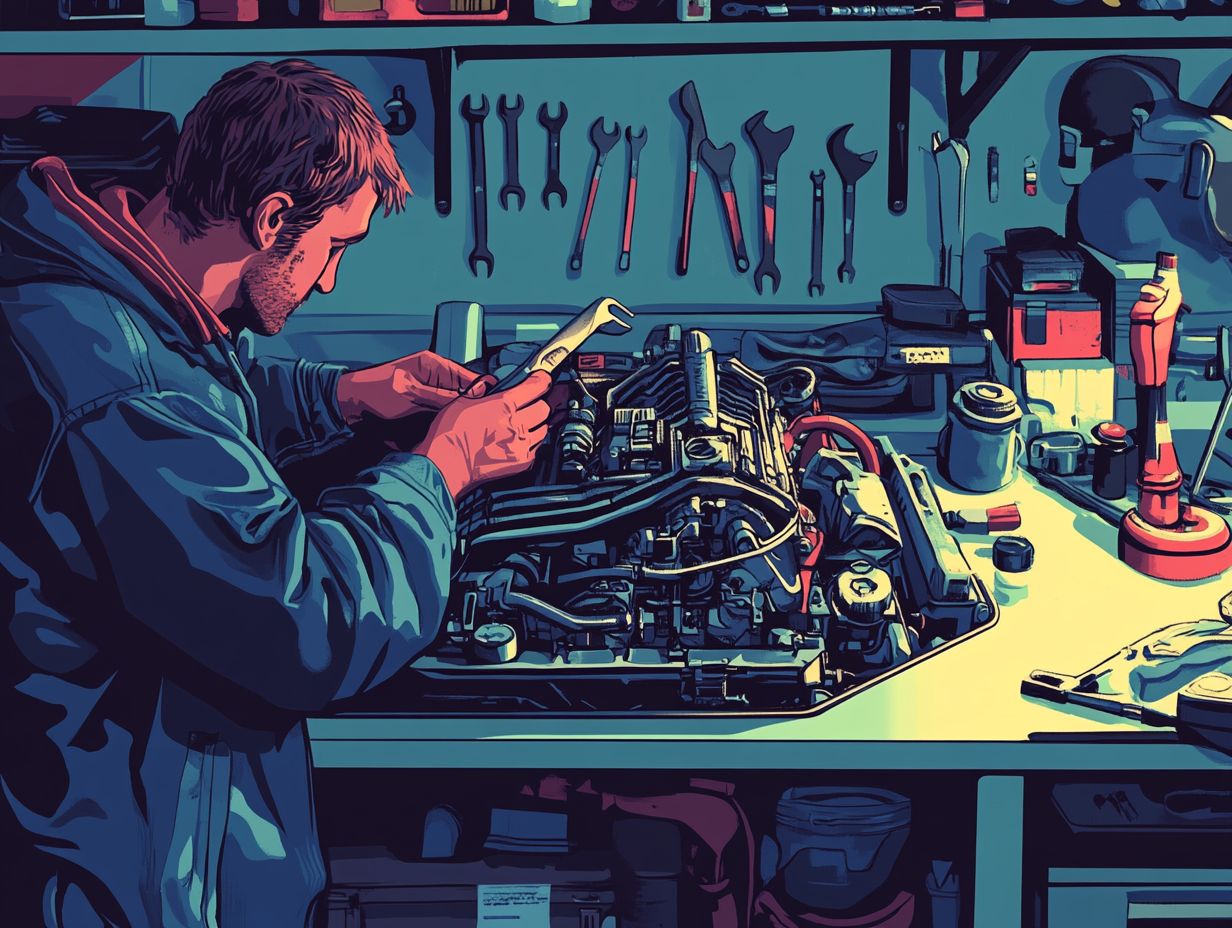
DIY car maintenance stands for “do-it-yourself” car maintenance. It refers to any maintenance or repair tasks that a car owner can do on their own, without the help of a professional mechanic.
Why should I do DIY car maintenance?
DIY car maintenance can save you money in the long run, as you won’t have to pay for labor costs at a mechanic. Additionally, it provides a better understanding of your car and its needs, allowing you to catch potential issues early on.
What are some simple DIY car maintenance tasks?
Some simple DIY car maintenance tasks include changing your own oil, replacing air filters, and checking and topping off fluids like coolant and brake fluid.
Can I do DIY car maintenance even if I have no mechanical experience?
Yes, there are many simple DIY car maintenance tasks that don’t require any previous mechanical experience. Just make sure to research and follow instructions carefully, including using the essential tools for DIY car maintenance, to avoid mistakes.
Are there any risks associated with DIY car maintenance?
Yes, there are risks involved with DIY car maintenance. If you don’t have the proper tools or knowledge, you could potentially cause further damage to your car. It’s important to know your limits and always seek professional help if needed.
Do I still need to take my car to a mechanic if I do DIY car maintenance?
Yes, it’s recommended to still take your car to a mechanic for regular check-ups and maintenance. They have the expertise and equipment to catch potential issues that may have been overlooked during DIY maintenance.


